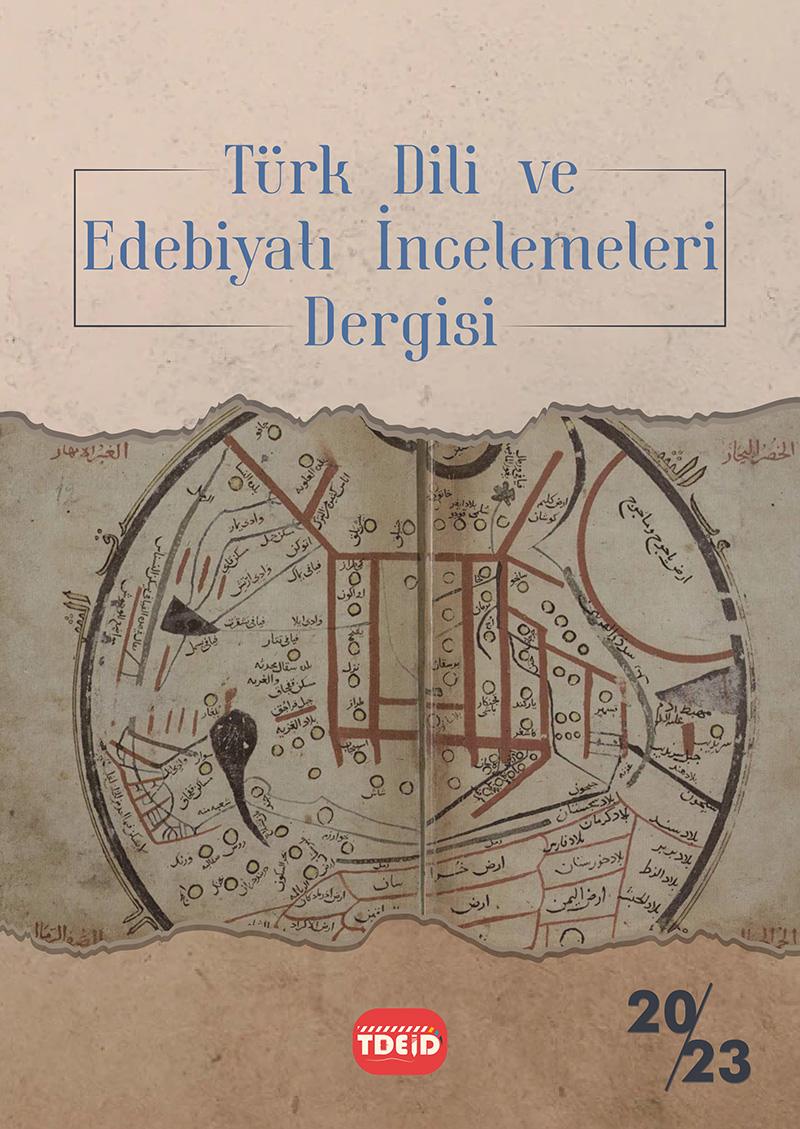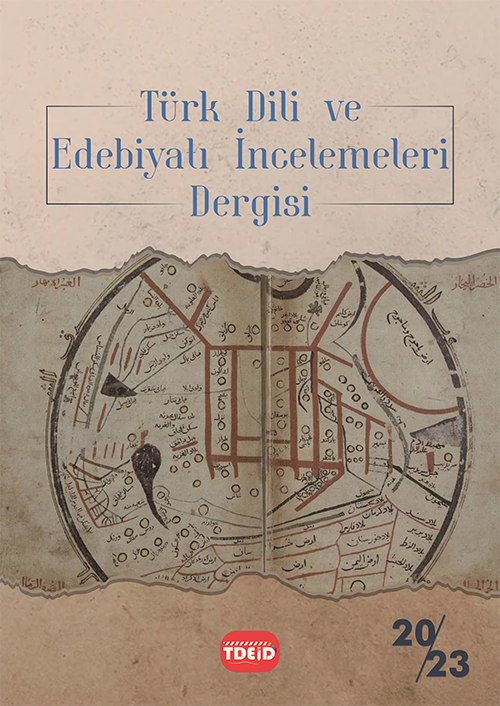Serialization Function of Turkish Converbs: Example of Old Anatolian
DOI:
https://doi.org/10.5281/zenodo.8209397Keywords:
converb, serial verb, serializationAbstract
In many languages; multiple verbs that come one after the other to express a single sentence and that do not contain any conjunctions or connection elements form “serial verb constructions” (SVC). This sorting of more than one verb is called serialization. These constructions act as a single verb in the sentence and do not contain any coordination or subordination relations. The verbs in SVC are usually sequentially in the form of infinitives and do not include any connection elements, but in some languages such as Turkish, Japanese and Korean, two verbs can form SVC with the help of an converb. The inclusion of these formations, which are contrary to the general characteristics of SVC, in the SVC category made it necessary to include the verb serialization function in coordination or subordination and adverbial functions. The phrase frequently used in Turkish is alıp gel- gidip gör, çekip git-, etc. serial verb constructions, more than one verb comes one after the other and emphasizes a single event; more than one verb acts as a single verb in a sentence. Particularly in motion events consisting of more than one stage, the element that provides serialization is an converb. Similar usages are widely used in the historical and contemporary periods of Turkish. Such usages are also frequently encountered in the Old Anatolian Turkish period.
References
Aikhenvald, Alexandra Y. (2006) Serial Verb Constructions in Typological Perspective, In Serial Verb Constructions, edited by Alexandra Y. Aikhenvald and R.M.W. Dixon, 1-68. Oxford: Oxford UP.
Asqar, Orazaqin (2009). Qazaq žäne Älem Xalïqtarïnïŋ Ertegileri, Almaty: Balawsa.
Aydemir, İbrahim Ahmet (2012). Türkiye Türkçesinde Zarf-Fiil Cümlelerinde Sözcük Sıralaması Üzerine, Gazi Türkiyat, Güz 2012/11: 227-233
Aydemir, İbrahim Ahmet (2019). Çağdaş Türk Dillerinde Sıralı Fiil Yapıları, X. Uluslararası Dünya Dili Türkçe Sempozyumu Bildiri Kitabı, s.155-163.
Bacanlı, Eyüp (2013). Güney Sibirya Türk Dillerinde Birleşik Fiillerle İlgili Teorik Sorunlar, Uluslararası Sosyal Araştırmalar Dergisi 6/24. 27-33.
Banguoğlu, Tahsin (2007). Türkçenin Grameri, Ankara: TDK Yayınları.
Bickel, Balthasar (1998). Review article of ‘Converbs in cross-linguistic perspective’, Linguistic Typology 2. 381-397.
Bisang, Walter (1995). Verb Serialization and Converbs-Differences and Similarities, König, E. & Haspelmath, M. (Yay.). Converbs in Cross-Linguistic Perspective, Berlin: Mouton de Gruyter. 137-188.
Bril, Isabelle (2004). Complex Nuclei in Oceanic Languages: Contribution to an Areal Typology. Complex Predicates in Oceanic Languages. Studies in the Dynamics of Binding an Boundness, Isabelle Bril and Françoise Ozanne-Rivierre (eds.), 1-48. Berlin/New York: Mouton de Gruyter
Bridges, Michelle (2008). Auxiliary Verbs in Uyghur. PhD thesis, University of Kansas.
Christaller, Johann Gottlieb (1875). A Grammar of the Asante and Fante Language Called Tshi[Chwee, Twi] Based on the Akuapem Dialect with Reference to the Other (Akan and Fante) Dialects, Basel: Basel Evangelical Mission Society
Çiğil, Abdullah (2022). Eski Anadolu Türkçesinde Seri Fiil Yapıları, Doktora Tezi, Nevşehir: Hacı Bektaş Veli Üniversitesi Sosyal Bilimler Enstitüsü.
Deniz Yılmaz, Özlem (2009), Türkiye Türkçesinde Eylemsi, Ankara: TDK Yayınları.
Dizdaroğlu, Hikmet (1963). Türkçede Fiiller, Ankara: TDK Yayınları.
Doğan, Talip (2017). Türkiye Türkçesi ve Horasan Türkçesinin Bocnurd Ağzında “Ve” Anlamında Sıralamanın Görünümü, Türk Dünyası Dil ve Edebiyat Dergisi, S 43, Bahar, s. 87-105.
Durie, Mark (1997). Grammatical Sructures in Verb Serialization, Complex Predicates. (ed. Alex Alsina-Joan Bresnan - Peter Sells). Stanford: CSLI Publications: 289–354.
Ediskun, Haydar (2007). Türk Dilbilgisi, Remzi Kitabevi: İstanbul.
Ergin, Muharrem (1993). Türk Dil Bilgisi, İstanbul: Bayrak Yayınları.
Givón, Thomas (2006). Multiple Routes to Clause Union: The diachrony of Syntactic Complexity, Seminario de Complejidad Sintáctica, Sonora, Mexico
Gökçe, Faruk (2013). Gramerleşme Teorisi ve Türkçe Fiil Birleşmeleri, Ankara: TKAE Yayınları.
Graschenkov, Pavel (2015). Turkic Converbs and Serialization: Syntax, Semantics, Grammaticalization, Moscow: Yazyki Slavyanskoj Kultury.
Gülsevin, Gürer (2001). Türkiye Türkçesinde Birleşik zarf-fiiller, Afyon Kocatepe Üniversitesi Sosyal Bilimler Dergisi, 2(2), 125-144.
Haspelmath, Martin (1999). Converb, Concise Encyclopedia of Grammatical Categories, Keith Brown and Jim Miller (eds.), 110-115. Oxford: Elsevier.
Haspelmath, Martin (1995). The Converb As A Cross-Linguistically Valid Category, Haspelmath, M. & König, E. (Yay.), Converbs in Cross-Linguistic Perspective: Structure and Meaning of Adverbial Verb Forms- Adverbial Participles, Gerunds. Berlin: Mouton de Gruyter, 1-55.
Hengirmen, Mehmet (2006). Türkçe Temel Dilbilgisi, Ankara: Engin Yayınevi.
Hirik, Erkan (2019). Seri Fiil Yapıları ve Türkçe, Karadeniz Araştırmaları XVI/61: 120-141.
Hirik, Erkan & Çiğil, Abdullah (2021). Seri Fiillerde Tür Değişimi ve Sözlükselleşme, Akademik Dil ve Edebiyat Dergisi, 5 (2) , 688-715. DOI: 10.34083/akaded.938310
Johanson, Lars (1992). Periodische Kettensätze im Türkischen, Wiener Zeitschrift für Kunde des Morgenlandes 80. 201-211.
Johanson, Lars (1995) On Turkic converb clauses. In Martin Haspelmath & Ekkehard König (eds.), Converbs in Cross-Linguistic Perspective: Structure and Meaning of Adverbial Verb Forms -Adverbial Participles, Gerunds. Vol. 13 (Empirical approaches to language typology), 313-347. Berlin: de Gruyter.
Karaağaç, Günay (1997). Lutfî Dîvânı (Giriş-Metin-Dizin-Tıpkıbasım) Ankara: TDK Yayınları.
Koç, Nurettin (1990). Yeni Dilbilgisi, İstanbul: İnkılâb Kitabevi.
Korkmaz, Zeynep (2007). Türkiye Türkçesi Grameri (Şekil Bilgisi), Ankara: TDK Yayınları.
Korkmaz, Zeynep (2009). Anadolu’da Oğuz Türkçesi Temelinde İlk Yazı Dilinin Kuruluşu, Türk Dili Araştırmaları Yıllığı-Belleten, 57 (2), 61-69.
Nedjalkov, Vladimir (1995). Some Typological Parameters of Converbs. Haspelmath, Martin and König, Ekkehard (eds), Converbs in Crosslinguistic Perspective: Structure and Meaning of Adverbial Verb Forms-Adverbial Participles, Gerunds. Berlin: Mouton de Gruyter, 97-136.
Reichl, Karl (1982). Türkmenische Märchen. Bochum: Studienverlag Brockmeyer.
Sebba, Mark (1987). The Syntax Of Serial Verbs: An Investigation into Serialisation in Sranan and Other Languages. Amsterdam: John Benjamins.
Shibatani, Masayoshi (2009). On The Form of Complex Predicates: Demystifying Serial Verbs. Berlin: Mouton de Gruyter.
Slobin, Dan (1996). From ‘thought and language’ to 'thinking for speaking’, In J. Gumperz & S.
Levinson (eds.), Rethinking linguistic relativity (70-96). Cambridge: Cambridge University
Press.
Straughn, Christopher (2011) Evidentiality in Uzbek And Kazakh, Dissertation Thesis, Chicago: Faculty Of The Division Of The Humanities.
Sugar, Alexander, Dylan (2019) Verb-linking and Events in Syntax: The Case of Uyghur -(i)p Constructions, Dissertation Thesis, Washington: University of Washington Department of Linguistics .
Talmy, Leonard (1985). Lexicalization patterns: Semantic structure in lexical forms. In T. Shopen (Ed.), Language Typology and Syntactic Description (pp. 36-149). Cambridge: Cambridge University Press.
Talmy, Leonard (2000). Toward a Cognitive Semantics, Cambridge: MIT Press.
Vittrant, Alice (2012). How typology allows for a new analysis of the verb phrase in Burmese, LIDIL-Revue De Linguistique Et De Didactique Des Langues, UGA Editions,46, pp.101-126.
Washington, Jonathan North-Tyers, Francis (2019). Delineating Turkic non-finite Verb Forms By Syntactic Function. Proceedings of the Workshop on Turkic and Languages in Contact with Turkic 4. 132–146.
Downloads
Published
How to Cite
Issue
Section
License
Copyright (c) 2023 Türk Dili ve Edebiyatı İncelemeleri Dergisi

This work is licensed under a Creative Commons Attribution 4.0 International License.







